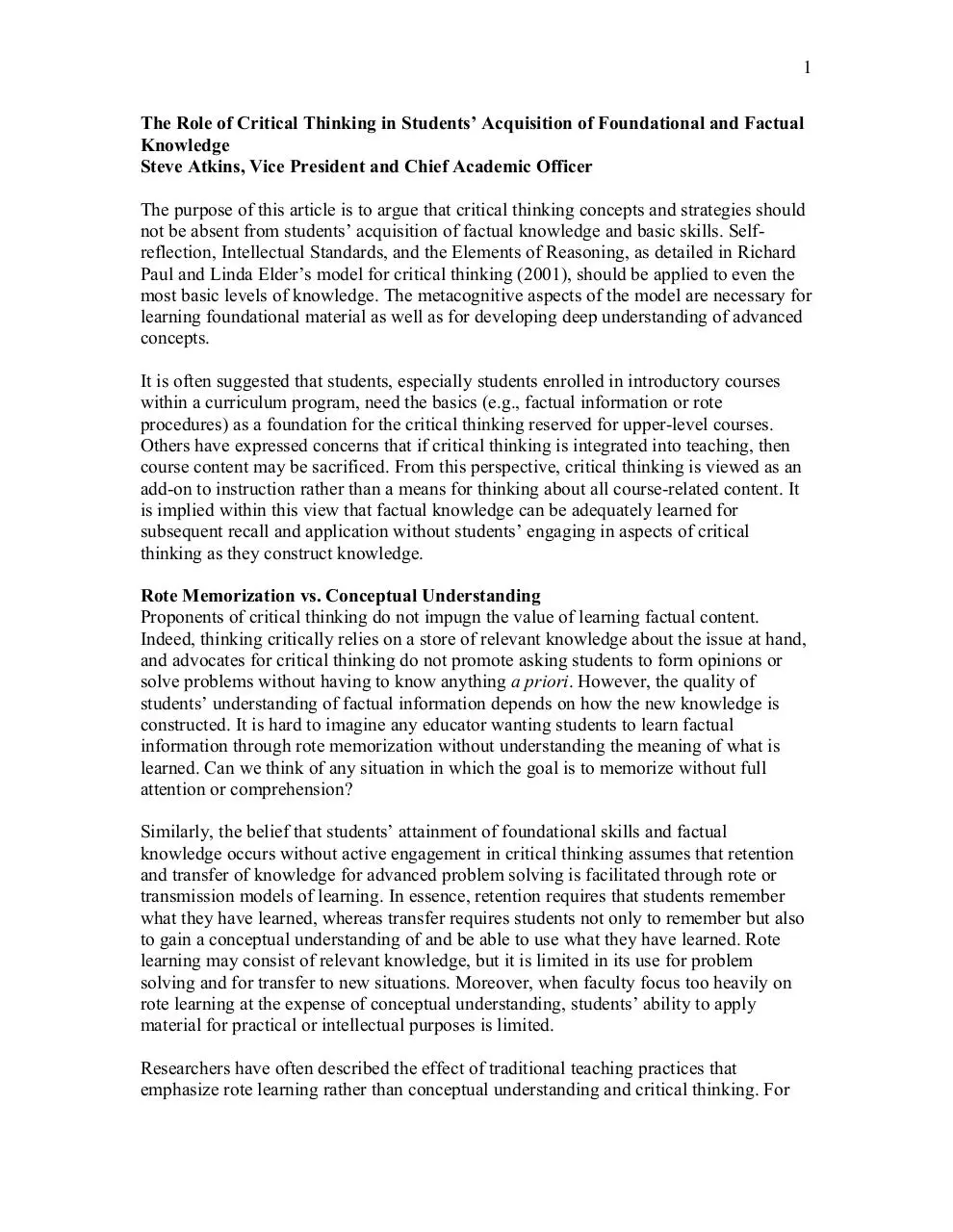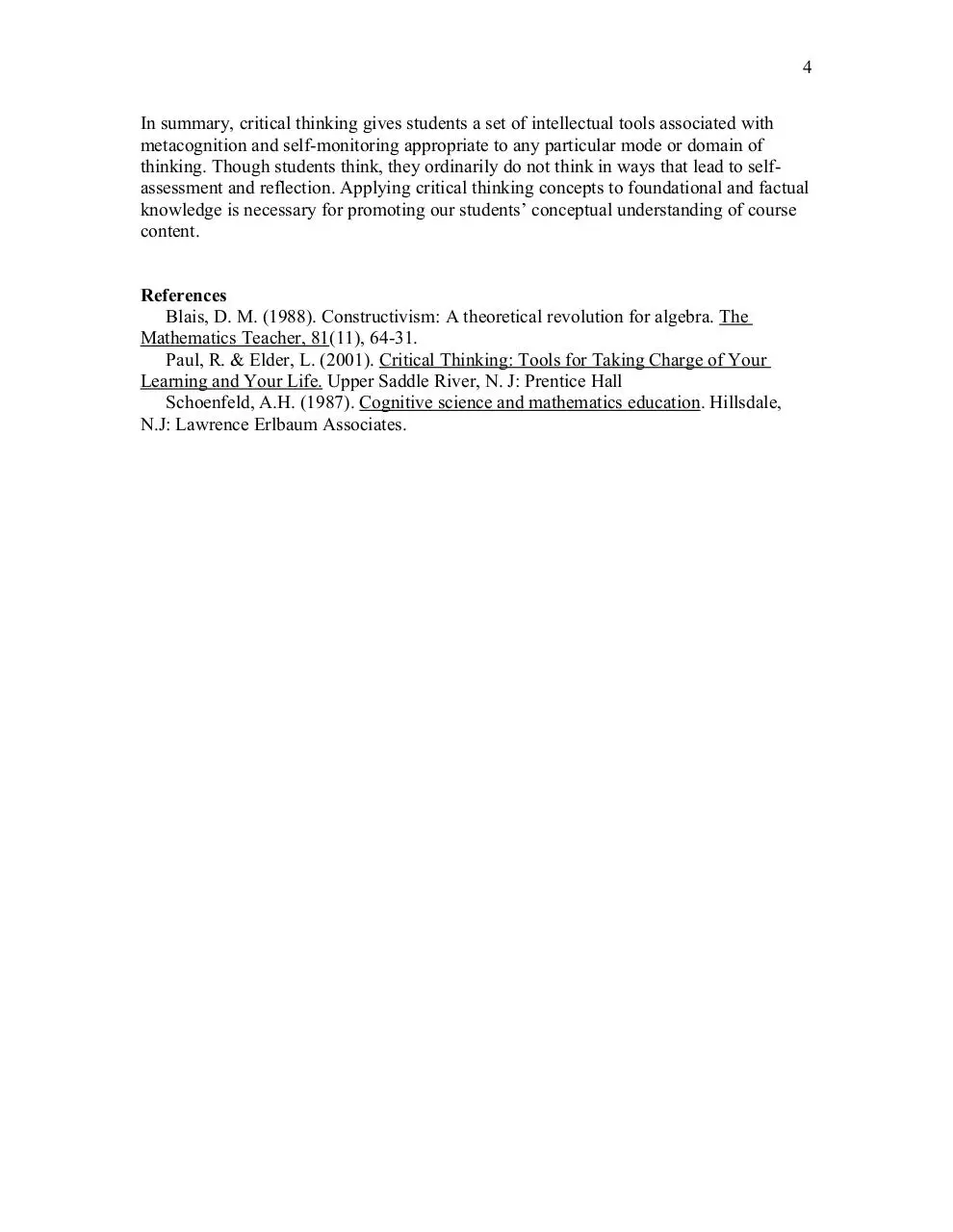AtkinsCTArticleforJune2004new (PDF)
File information
Title: The purpose of this article is to argue that critical thinking concepts and strategies should not be absent from students’ acq
Author: h256_1
This PDF 1.4 document has been generated by Writer / LibreOffice 4.3, and has been sent on pdf-archive.com on 18/12/2014 at 18:13, from IP address 71.3.x.x.
The current document download page has been viewed 563 times.
File size: 93.21 KB (5 pages).
Privacy: public file





File preview
1
The Role of Critical Thinking in Students’ Acquisition of Foundational and Factual
Knowledge
Steve Atkins, Vice President and Chief Academic Officer
The purpose of this article is to argue that critical thinking concepts and strategies should
not be absent from students’ acquisition of factual knowledge and basic skills. Selfreflection, Intellectual Standards, and the Elements of Reasoning, as detailed in Richard
Paul and Linda Elder’s model for critical thinking (2001), should be applied to even the
most basic levels of knowledge. The metacognitive aspects of the model are necessary for
learning foundational material as well as for developing deep understanding of advanced
concepts.
It is often suggested that students, especially students enrolled in introductory courses
within a curriculum program, need the basics (e.g., factual information or rote
procedures) as a foundation for the critical thinking reserved for upper-level courses.
Others have expressed concerns that if critical thinking is integrated into teaching, then
course content may be sacrificed. From this perspective, critical thinking is viewed as an
add-on to instruction rather than a means for thinking about all course-related content. It
is implied within this view that factual knowledge can be adequately learned for
subsequent recall and application without students’ engaging in aspects of critical
thinking as they construct knowledge.
Rote Memorization vs. Conceptual Understanding
Proponents of critical thinking do not impugn the value of learning factual content.
Indeed, thinking critically relies on a store of relevant knowledge about the issue at hand,
and advocates for critical thinking do not promote asking students to form opinions or
solve problems without having to know anything a priori. However, the quality of
students’ understanding of factual information depends on how the new knowledge is
constructed. It is hard to imagine any educator wanting students to learn factual
information through rote memorization without understanding the meaning of what is
learned. Can we think of any situation in which the goal is to memorize without full
attention or comprehension?
Similarly, the belief that students’ attainment of foundational skills and factual
knowledge occurs without active engagement in critical thinking assumes that retention
and transfer of knowledge for advanced problem solving is facilitated through rote or
transmission models of learning. In essence, retention requires that students remember
what they have learned, whereas transfer requires students not only to remember but also
to gain a conceptual understanding of and be able to use what they have learned. Rote
learning may consist of relevant knowledge, but it is limited in its use for problem
solving and for transfer to new situations. Moreover, when faculty focus too heavily on
rote learning at the expense of conceptual understanding, students’ ability to apply
material for practical or intellectual purposes is limited.
Researchers have often described the effect of traditional teaching practices that
emphasize rote learning rather than conceptual understanding and critical thinking. For
2
example, Donald Blais (1988) stated that traditional teaching in mathematics that
involves giving students a maximum of explanation implies the creation of a listenerfollower role for students. Such a role, he conjectures, contributes to dependence, fosters
the growth of learned helplessness, and encourages students to memorize information
instead of constructing robust knowledge structures. Blais contended that traditional
mathematics courses focus too much on transmitting content at the expense of thought
processes. He felt that the focus should be on the development of thinking skills and
conceptual understanding.
The Role of Metacognition
The essence of Paul and Elder’s model for critical thinking is metacognition: applying
intellectual tools to assess and monitor thinking in order to make thinking better—more
clear, more accurate, more defensible. Current literature in mathematics and science
education supports an emphasis on metacognition for all levels of instruction—arithmetic
through calculus and beyond. Metacognition focuses on methodology which develops
students’ metacognitive skills, meaning one’s own knowledge concerning one’s own
thoughts. In particular, research on the role of metacognition in problem solving has been
concerned with two related components: (a) knowledge of one’s own thought processes
and (b) regulation and monitoring of one’s activity during problem solving. Alan
Schoenfeld (1987) asserted that good problem solving calls for using effectively what
you know: “If you don’t have a good sense of what you know, you may find it difficult to
be an efficient problem solver” (p. 190).
Elements of Reasoning and Intellectual Standards
To further explore the relevance of critical thinking to the acquisition of factual or
foundational knowledge, consider the effects of excluding aspects of Paul and Elder’s
Elements of Reasoning and Intellectual Standards from the teaching/learning process.
First, consider a learning environment where one (or more) of the Elements of Reasoning
is not accessible for students’ learning. In this event, students learn content without
understanding (1) the purpose of this information within a conceptual framework, (2)
how the information is used in an attempt to figure something out, (3) how the
information could be used to support or challenge students’ assumptions or points of
view, (4) how the information shapes concepts, etc. Hence, factual knowledge without
the Elements of Reasoning becomes irrelevant and disconnected to concepts at hand and
detached from its value or practical use. Without the Elements, facts are not integrated
within the larger conceptual framework to which they relate.
3
Elements of Reasoning
All reasoning has a purpose.
All reasoning is an attempt to figure something out, to settle some
question, to solve some problem.
All reasoning is based on assumptions.
All reasoning is done from some point of view.
All reasoning is based on data, information, and evidence.
All reasoning is expressed through, and shaped by, concepts and ideas.
All reasoning contains inferences by which we draw conclusions and give
meaning to data.
All reasoning leads somewhere, has implications and consequences.
Paul and Elder’s Intellectual Standards are defined as universal intellectual standards
which are applied to thinking whenever one is interested in checking the quality of
reasoning about a problem, issue, or situation. To help students learn course content, Paul
and Elder suggest that instructors should pose questions which probe student thinking,
hold students accountable for their thinking, and, through consistent use by instructors in
the classroom, become internalized by students as questions they need to ask themselves.
Paul and Elder assert that these questions need to become ingrained in students’ inner
voices, guiding them to better thinking. As in the previous example, the exclusion of one
or more standards suggests that students learn content but are not held accountable for
knowing and communicating the content clearly, accurately, precisely, with relevance, in
depth, or with logic. Hence, excluding intellectual standards from learning suggests the
occurrence of rote/superficial learning and teaching. Moreover, having students inculcate
the standards into their thinking provides them with the metacognitive tools suggested by
Schoenfeld as necessary for effective problem solving.
Intellectual Standards
Clarity
Accuracy
Precision
Relevance
Depth
Breadth
Logic
4
In summary, critical thinking gives students a set of intellectual tools associated with
metacognition and self-monitoring appropriate to any particular mode or domain of
thinking. Though students think, they ordinarily do not think in ways that lead to selfassessment and reflection. Applying critical thinking concepts to foundational and factual
knowledge is necessary for promoting our students’ conceptual understanding of course
content.
References
Blais, D. M. (1988). Constructivism: A theoretical revolution for algebra. The
Mathematics Teacher, 81(11), 64-31.
Paul, R. & Elder, L. (2001). Critical Thinking: Tools for Taking Charge of Your
Learning and Your Life. Upper Saddle River, N. J: Prentice Hall
Schoenfeld, A.H. (1987). Cognitive science and mathematics education. Hillsdale,
N.J: Lawrence Erlbaum Associates.
5
Download AtkinsCTArticleforJune2004new
AtkinsCTArticleforJune2004new.pdf (PDF, 93.21 KB)
Download PDF
Share this file on social networks
Link to this page
Permanent link
Use the permanent link to the download page to share your document on Facebook, Twitter, LinkedIn, or directly with a contact by e-Mail, Messenger, Whatsapp, Line..
Short link
Use the short link to share your document on Twitter or by text message (SMS)
HTML Code
Copy the following HTML code to share your document on a Website or Blog
QR Code to this page

This file has been shared publicly by a user of PDF Archive.
Document ID: 0000199753.